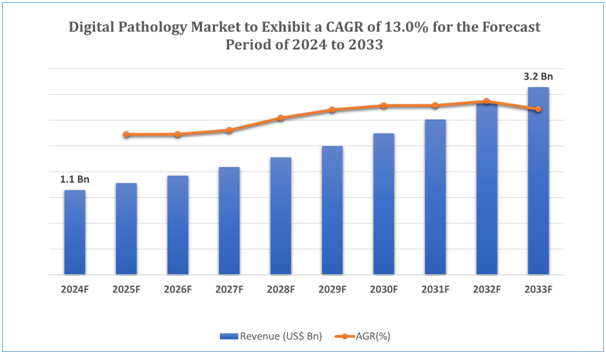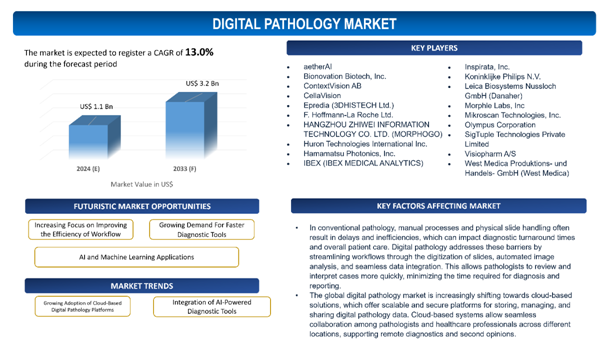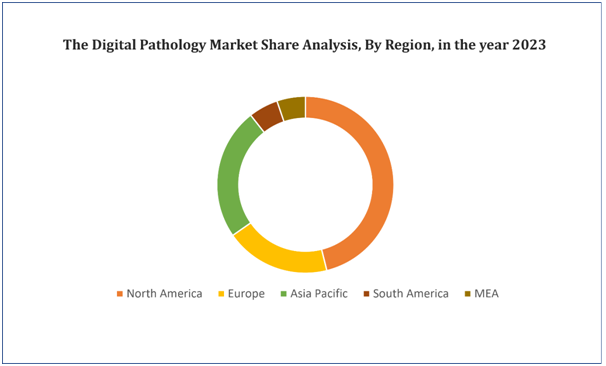Digital PathologyMarket Overview
The global digital pathology market is estimated to be worth over USD 3.2 Bnin 2033 and is expected to grow at CAGR of13.0% during the forecast period (2024-2033).
Digital pathology is essentiallyredefining the healthcare outlook by transitioning the field of pathology from a conventionally analog, slide-based practice to a highly integrated digital environment. This shift is upheld by the confluence of advanced imaging technologies, artificial intelligence (AI), and robust data management systems. Conventionally, pathologists would analyze tissue samples on glass slides under a microscope. This approach, while effective, is confined by physical constraints, such as the necessity for in-person analysis and the challenges of storing and retrieving physical slides. Digital pathology, however, comprises scanning these glass slides to create high-resolution digital images that can be viewed, analyzed, and shared electronically.
One of the most critical impacts of digital pathology is its capability to support remote consultations and second opinions. Digital slides can be simply shared with pathologists and specialists across the world, breaking down geographical barriers and ensuring that patients have access to expert analysis irrespective of their location. This is especially valuable in regions with limited access to specialized medical expertise. The capability to store and access digital images also improves the efficiency of pathological workflows, minimizing the time required for analysis and reporting.
AI holds a crucial role in amplifying the benefits of digital pathology. By automating routine tasks, such as determining and quantifying specific types of cells or identifying abnormal tissue patterns, AI minimizes the workload on pathologists and increases diagnostic accuracy. Machine learning algorithms can assessextensive datasets, unveiling subtle patterns that may be overlooked by human observation, leading to earlier and more precise diagnoses. This is especially critical in the diagnosis of complex diseases, such as cancer, where early and accurate detection can significantly enhance patient outcomes.
As healthcare systems globally grapple with the dual pressures of enhancing patient outcomes while minimizing costs, digital pathology offers a promising solution. It not only improves the precision and scalability of diagnostic services but also aligns with the broader goals of precision medicine and integrated healthcare. By setting a new standard in pathology, digital pathology stands ready to hold a major role in the future of healthcare, fueling innovations that will benefit patients and healthcare providers alike.
Figure 1. Digital Pathology: Market Size

Get more details on this report - Request Free Sample
Key Market Insights
The global digital pathology market is witnessingswift growth, driven by technological advancements, the growing adoption of AI and machine learning, and the increasing demand for remote diagnostics and personalized medicine. The market is experiencingsubstantial investments in digital imaging, advanced analytics, and cloud-based platforms, which are improving the capabilities of pathology labs and allowing real-time data sharing across global networks. Significant developments in the market comprise the integration of AI-driven diagnostic tools that automate routine tasks, enhance accuracy, and minimize turnaround times. In addition, novel technologies like whole slide imaging (WSI) and cloud-based digital pathology platforms are gaining momentum, offering scalable and efficient solutions for data storage, management, and remote consultations.
The current market landscape is marked by a rising collaboration between healthcare providers, technology companies, and research institutions to develop advanced digital pathology solutions. The COVID-19 pandemic has propelled the adoption of digital pathology, as healthcare systems worldwide have progressively relied on remote diagnostics and telepathology to ensure continuity of care. Key players in the market are emphasized on expanding their product portfolios through strategic acquisitions, partnerships, and the development of AI-powered tools that improve diagnostic accuracy and workflow efficiency. As regulatory frameworks evolve to facilitate digital health technologies, the global digital pathology market is poised for sustained expansion, with major opportunities in both developed and emerging markets, especially in regions where access to specialized pathology services is confined.
Market Dynamics
Market Drivers
Increasing Focus on Improving the Efficiency of Workflow
In conventional pathology, manual processes and physical slide handling often result in delays and inefficiencies, which can impact diagnostic turnaround times and overall patient care. Digital pathology addresses these barriers by streamlining workflows through the digitization of slides, automated image analysis, and seamless data integration. This allows pathologists to review and interpret cases more quickly, minimizing the time required for diagnosis and reporting.
In addition to that, digital pathology supports centralized data management, enabling multiple specialists to collaborate on cases in real-time, irrespective of their geographical location. This not only speeds up the diagnostic process but also improves the accuracy of diagnoses by allowing access to second opinions and specialized expertise without the need for physical slide transfer. Automation, powered by AI and machine learning, further contributes to workflow efficiency by automating routine tasks such as tissue quantification and abnormality detection, freeing up pathologists to aim on more complex analyses. As healthcare systems worldwide focuson enhancing productivity and minimize costs, the efficiency gains offered by digital pathology make it an increasingly attractive solution, boosting its adoption across both developed and emerging markets.
Market Restraints
With regard to numerous advantages of digital pathology, the market faces several challenges due to the unique characteristics and requirements associated with these potent pharmaceutical products. Some of the key market challenges include:
- High Initial Costs and Infrastructure Requirements: The adoption of digital pathology needs significant upfront investment in advanced imaging equipment, software, and data storage solutions. In addition, healthcare facilities need to upgrade their IT infrastructure to support the large digital files and secure data transmission. These costs can be prohibitive, especially for smaller clinics or hospitals in developing regions, confining the widespread adoption of digital pathology.
- Regulatory and Legal Challenges: The global digital pathology market is subject to complex regulatory frameworks that vary by region. Ensuring compliance with these regulations, especially concerning data security, patient privacy, and the validation of digital diagnostic tools, can be challenging. In addition to that, the legal acceptance of digital pathology results in clinical practice is still evolving in some regions, which can hamper the entire integration of digital pathology into routine clinical workflows.

Get more details on this report - Request Free Sample
Market Opportunity
AI and Machine Learning Applications
AI and machine learning applications present a significant market opportunity for the global digital pathology market by improving the efficiency, accuracy, and scalability of diagnostic processes. These technologies allow the automation of routine tasks, such as cell counting, tissue analysis, and pattern recognition, which traditionally require manual interpretation by pathologists. By leveraging AI and machine learning, digital pathology platforms can assessextensive amounts of data quickly and with high precision, minimizing the risks of human error and enhancing diagnostic outcomes.
One of the major opportunities lies in the ability of AI-powered tools to determine subtle patterns and abnormalities in tissue samples that might be missed by the human eye. This capability is especially valuable in the early detection of complex diseases like cancer, where early and accurate diagnosis is critical for effective treatment. Machine learning algorithms can also continually learn and enhance from new data, making them increasingly effective over time and allowing more personalized and targeted patient care.
In addition, AI and machine learning encourage the development of predictive analytics in pathology. By analyzing historical data and identifying trends, these technologies can help predict disease progression and patient outcomes, facilitatingproactive and preventive healthcare strategies. This not only improves patient care but also optimizes resource allocation in healthcare facilities.
As the demand for precision medicine grows, AI and machine learning applications in digital pathology offer significant potential to fuel innovation, enhance patient outcomes, and create new business opportunities. This makes them a major area of focus for companies looking to expand their presence in the digital pathology market.
Market Trends
- Growing Adoption of Cloud-Based Digital Pathology Platforms: The global digital pathology market is increasingly shifting towards cloud-based solutions, which offer scalable and secure platforms for storing, managing, and sharing digital pathology data. Cloud-based systems allow seamless collaboration among pathologists and healthcare professionals across different locations, supporting remote diagnostics and second opinions. This trend is particularly fueled by the need for efficient data management, reduced infrastructure costs, and improved accessibility in both developed and emerging markets.
- Integration of AI-Powered Diagnostic Tools: There is a soaring trend of integrating AI and machine learning algorithms into digital pathology platforms to improve diagnostic accuracy and efficiency. These AI-powered tools assist pathologists by automating routine tasks such as detecting and quantifying cellular abnormalities, assessing large datasets, and offering predictive insights. The continuous improvement of these algorithms, along with their ability to learn from extensive amounts of data, is driving their adoption and creating new opportunities for advanced diagnostics and personalized medicine within the digital pathology market.
Digital Pathology Market: Key Segments
By Product
- Software
- Device
- Scanners
- Slide Management System
- Storage System
By Type
- Human Pathology
- Veterinary Pathology
By Application
- Drug Discovery & Development
- Academic Research
- Disease Diagnosis
- Cancer Cell Detection
- Others
By End-Use
- Hospitals
- Biotech & Pharma Companies
- Diagnostic Labs
- Academic & Research Institutes
By Key Geographical Regions
- North America
- Europe
- Asia-Pacific
- Middle East and Africa
- South America
Figure 4. Digital Pathology Market: Distribution by Region

Get more details on this report - Request Free Sample
Digital Pathology Market: Regional Analysis
North America dominated overall market in 2023 with a share of 40.7% due to increasing government initiatives leading to the development of technologically advanced pathologies, continual deployment of R&D investments, rising adoption of digital imaging, and presence of key market players in the region focusing on providing better solutions to the population.
Asia Pacific is expected to grow at the fastest CAGR from 2024 to 2030. This growth is attributed to rapid digitalization, a rising focus on investments in the medical field, and a rising digital imaging penetration in developing economies. The region shows an increasing prevalence of cancer, which propels the need for novel treatment options, further boosting market growth.
Leading Digital Pathology Developers
Industry Trends and Global Forecasts, 2023-2035 report features an extensive study of the current market landscape, market size and future opportunities associated with the Digital Pathologymarket, during the given forecast period. Further, the market report highlights the efforts of several stakeholders engaged in this rapidly emerging segment of the biopharmaceutical industry. Key takeaways of the Digital Pathologymarket are briefly discussed below.
The report includes the list of players operating in the global digital pathology market. Some of the key players include:
- aetherAI
- Bionovation Biotech, Inc.
- ContextVision AB
- CellaVision
- Epredia (3DHISTECH Ltd.)
- F. Hoffmann-La Roche Ltd.
- HANGZHOU ZHIWEI INFORMATION TECHNOLOGY CO. LTD. (MORPHOGO)
- Huron Technologies International Inc.
- Hamamatsu Photonics, Inc.
- IBEX (IBEX MEDICAL ANALYTICS)
- Inspirata, Inc.
- Koninklijke Philips N.V.
- Leica Biosystems Nussloch GmbH (Danaher)
- Morphle Labs, Inc
- Mikroscan Technologies, Inc.
- Olympus Corporation
- SigTuple Technologies Private Limited
- Visiopharm A/S
- West Medica Produktions- und Handels- GmbH (West Medica)
Digital Pathology Market: Key Developments
- In August 2024, Indica Labs, the leading provider of AI-powered digital pathology solutions, announced the launch of Lung Macrodissect AI, a groundbreaking tool that revolutionizes slide macrodissection and molecular pathology workflows. Lung Macrodissect AI represents a significant leap forward for the integration of artificial intelligence with digital pathology by offering pathologists a streamlined macrodissection workflow that minimizes human error and improves efficiency.
Scope of the Report
The market report presents an in-depth analysis of the various firms / organizations that are engaged in this market, across different segments, as defined in the below table:
|
|
Key Report Attributes |
Details |
||
|
|
Base Year |
2023 |
||
|
|
Forecast Period |
2024-2033 |
||
|
|
CAGR (2024-2033) |
13.0% |
||
|
|
Product |
|
||
|
|
Type |
|
||
|
|
Application |
|
||
|
|
End-Use |
|
||
|
|
Key Geographical Regions |
|
||
|
Key Companies Profiled |
|
|
||
